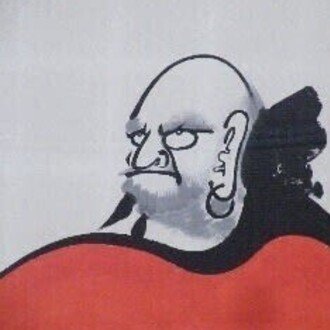
曽源池庭園の滝石組は、日本庭園の最高峰 ! The Takiishigumi in the Sogenchi Garden is the highest peak in the Japanese garden!
天龍寺の魅力のひとつに、初代住職で作庭家の夢窓疎石師が造った日本庭園の最高峰といわれる「曽源池庭園」がある。その庭園の北斜面から池の中にかけて組まれている滝石組は庭園のシンボル。その中でも、目に留まったのが池の中にある鋭く突き出た石組である。
One of the attractions of Tenryu-ji Temple is the "Sogenchi Garden", which is said to be the highest peak of the Japanese garden built by the first chief priest and garden maker Muso Soseki. The waterfall stone group that is built from the north slope of the garden to the pond is a symbol of the garden. Among them, the one that caught my eye was the sharply protruding stone set in the pond.
看板の説明によると、「釈迦三尊石」と称されるものらしい。中央が釈迦如来で、左側の石が文殊菩薩、手前が普賢菩薩と表されている。この釈迦三尊石と類似した石組が、拝観受付がある庫裏の前にも建てられている。
According to the explanation on the signboard, it seems to be called "Shaka Sanzonseki". The center is Shaka Nyorai, the stone on the left is Manjushri, and the front is Samantabhadra. A stone set similar to this Shaka Sanzon stone is also built in front of the kuri where the reception desk is located.


滝石組の説明は、庭園ガイドに写真付きの解りやすい解説があったので転載させていただいた。写真と照らし合わせながら読んでいただくとより解りやすい。
The explanation of Takiishigumi was reprinted because there was an easy-to-understand explanation with a photo in the garden guide.
It will be easier to understand if you read it while comparing it with the photo.
Aが鯉魚石(りぎょせき)である。鯉魚石とは、中国の鯉が滝を登ると龍になるという故事「登竜門」にちなんだ鯉を石に見立てたものである。天龍寺の鯉魚石は、鯉が滝を登り龍へと変化する瞬間を表現したきわめて珍しいものである。もちろん鯉が滝を登るようなことはできないが、ひたすら修行を繰り返すという禅の理念を石組で表したのを「龍門瀑(りゅうもんばく)」と呼ぶ。Cは遠山石で、不老不死の仙人が住む蓬莱山も表している。Dは水を落とす石「水落石」であり、三石あることで「三段の滝」となる。Bは三枚の石橋であり、自然石で作られた橋としては日本最古の例である。青石が使われ、細く上品な造形である。
A is a carp fish stone. Koi fish stone is a stone that is named after the "Toryumon", a Chinese carp that turns into a dragon when it climbs a waterfall. The carp fish stone at Tenryu-ji Temple is extremely rare, expressing the moment when a carp climbs a waterfall and turns into a dragon. Of course, it is not possible for a carp to climb a waterfall, but the Zen philosophy of repeating training is called "Ryumonbaku", which is a stone set. C is a Toyama stone, which also represents Horaisan, where the immortal hermit lives. D is a stone that drops water, "waterfall stone", and with three stones, it becomes a "three-tiered waterfall". B is three stone bridges, which is the oldest example of a bridge made of natural stone in Japan. Aoishi is used, and it is a thin and elegant model.

中国の仏教の教示や慣習が日本に伝わってきた中でも、日本の寺院建造物や庭園は、その影響を強く受けている。日本の仏教慣習や風習、風土にあうものを先達の人々が新しく創り上げてきた。
池泉回遊式庭園も枯山水庭園も、日本の独特な風土 “詫び寂び” の中で生まれ変わり、今に伝わってきた。
Even though Chinese Buddhist teachings and customs have been introduced to Japan, Japanese temple buildings and gardens are strongly influenced by them. The ancestors have created new things that match Japanese Buddhist customs, customs, and climate. Both the keisen strolling garden and the dry landscape garden have been reborn in Japan's unique climate of "Wabi & Sabi" and have been passed down to the present day.

レポート & 写真 / 渡邉雄二 滝石組 / 写真&コメントは「庭園ガイド」より転載
Reported & Photos by Yuji Watanabe
いいなと思ったら応援しよう!

